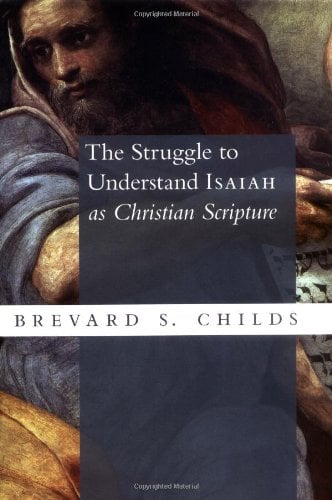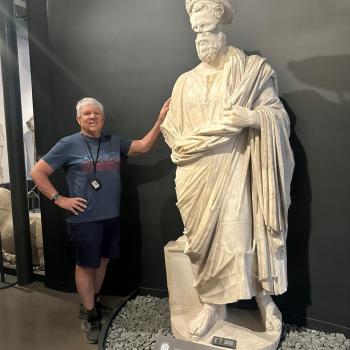The use of the notion of prophecy and fulfillment has always been a major way of trying to relate the two testaments, and in addition the notions of type and ante-type also aided the attempt to relate the two testaments. Christian thought has always fought to insist that the whole Bible is God’s Word, and no denigration of the OT or neglect of it is adequate as Christian theology. In the name of modern inter-faith dialogue, Brueggemann and R. Rendtorf have insisted that we should hear the voice of the Hebrew text itself independent of the NT and in essence not treat it as the OT. The NT reading of the OT is thereby seen as not normative, it’s just one more imaginative construal which can stand along other imaginative construals by Jewish or secular interpreters which are considered equally valid. Brueggemann denies any organic link between the OT and the NT, and he sees the attempt to make such a link as a political power move by Christians trying to displace Jewish religion and interpretation of their own Scriptures. He also denies there is any salvation history schema that links the testaments. The goal is the acceptance of the dignity and independent value of the Jewish religion and its scripture apart from Christianity.
Childs understands the impetus behind this approach and plea, but in the end rejects it. He says “Although there is a substantive distinction between promise and fulfillment, and between the old and the new covenant, Christians see in the Old Testament a genuine continuity with the New, integral to its textual meaning whether expressed in a pattern of sacred history or of an ontological unity undergirding the two testaments.”
It was Aquinas who first addressed the issue fully of the relationship of the divine and human authors of Scripture. He says God is the author and the human beings the instrumental cause of its being written (Summa 1.1.10), therefore there is no tension. The human authors intended the literal sense of what they wrote, but God who knows all intended more. Calvin used the theory of divine accommodation to explain the very human language and differences in the various texts.
One of the problems facing the Christian interpretation of the OT is the fact that the NT writers often used the LXX version, and it also often differed from the Hebrew text. “The linguistic filter provided by a translation can never exactly reproduce the original. Even when a translation strives for a literal rendering…”
These sorts of issues raise the question of which OT Christians should follow, or should their approach be eclectic, or should we agree with H. Hubner that the OT was authoritative for the Christian church only to the extent of its reinterpretation in the NT. Brueggemann even argues that the free way the NT writers use the OT provides a precedent and warrant for us to engage in equally free and creative construals of the text. Childs responds that the church has always affirmed a two testament canon which has Biblical authority over the life of the church. Each of the two testaments preserve their own integrity and each have their own function in one ongoing divine economy.
“It is a fundamental theological error for postmodernists to seek and analogy between the New Testament’s use of the Old Testament and a modern so-called ‘imaginative construal’ of the Bible. We are neither prophets nor evangelists, but rather our witness is built upon theirs. The function of the Christian canon was to separate the apostolic witness from the ongoing tradition of the church, whose truth was constantly in need of being tested by the apostolic faith….The exegetical task of seeking coherence between the testaments does not lie in ‘Christianizing’ the Old Testament, that is in substituting a New Testament understanding for the Old….The church confesses that the criterion of truth for both the Old Testament and the New Testament is Jesus Christ, the divine reality that undergirds the joint witness of its scriptures.”
He rejects the notion that meaning only emerges as an interaction between reader, text, and context and that all readings are local, not neutral or value free, and therefore all readings are subjective. He rejects the notion that the enterprise of getting at the meaning of the text is never truth seeking, it’s power-seeking, a political ploy. Post-modern interpretation then rejects a definite or absolute meaning in the text. He rejects Brueggemann’s insistence that a text is a neutral passive entity that must be rendered into a meaningful sense by the human endeavor of the interpreter.
In essence Brueggemann is denying that the Bible is God’s Word divinely inspired and that it has an inherent meaning, which it is our task to discern and apply, it is not our task to use the text to create a meaning for ourselves. Childs points out that even in the formation of the canon there were theological reasons for putting Deuteronomy last, and placing the four Gospels together, and finishing the canon with Revelation. According to Isaiah, God has a divine long-range even universal plan involving judgment and redemption of God’s people and of the world and no human beings can ultimately thwart his plan (Is. 14.26-27). As Childs points out, the Heilsgeschichte idea continues to resurface (Martin Kahler, Adolph Schlatter, Gerhard von Rad, and I would add Oscar Cullmann), though in a more critical and theologically profound way, of making sense of the relationship of the two testaments. I would add that the more recent narrative story approaches to the text also help in this endeavor. God’s divine activity in human history can’t simply be fused with nor should it be confused with secular history, but it also can’t be separated from it.
Childs argues that it is one thing to try and understand the OT as the sacred scriptures of the church, and another to study the Bible in a history of religions way. Both tasks are legitimate, but they should not be confused as they have differing aims, goals, and procedures. The history of religions approach implicitly denies that the Bible is divinely inspired and revealing the unique revelation and work of God. It tries to reconstruct Biblical history on the basis of common human experience. The result is two different approaches to exegesis based in two different understandings of history.













